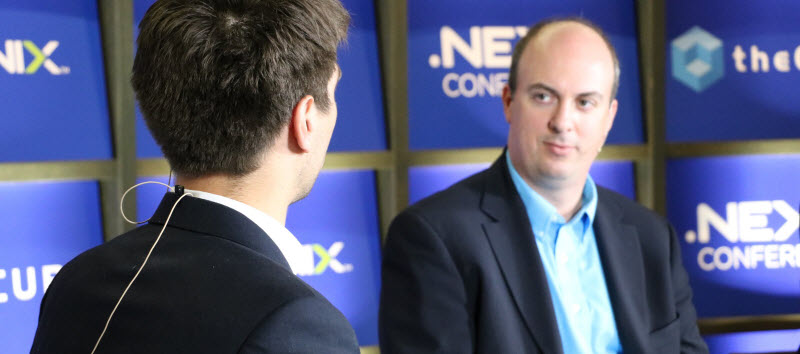 NEWS
NEWS
 NEWS
NEWS
 NEWS
NEWS
A feisty Nutanix, Inc. came out swinging at its recent user conference, taking on virtualization kingpin VMware, Inc. and seemingly setting its sights on Amazon Web Services in its bid to make data center infrastructure invisible.
Nutanix, which is perhaps the hottest startup in the converged infrastructure market, introduced a hardware-agnostic implementation of the software powering its hugely-popular integrated appliances and said it’s considering selling its software on a subscription basis, a move that would position it directly against VMware. Nutanix has raised more than $300 million in funding and reportedly is on a $300 million bookings pace, but can it take on two infrastructure heavyweights with a combined $32 billion in annual revenue, not to mention the powerful Amazon?
That’s question we put to Wikibon Senior Analyst Stuart Miniman, who follows cloud and infrastructure. “Lots of people running with the Nutanix vs VMware ‘war,’” he told us, “but the reality is that Nutanix is leading a wave of disruption in storage that has all the big companies like EMC, Hewlett-Packard [Co.] and others are paying a lot of attention.”
Nutanix started with a proposition of making storage invisible, thereby rendering the choice of storage provider nearly irrelevant. In March, the competition with EMC boiled over in an exchange of I-can-top-that top 10 lists between Nutanix Strategic Sales VP Steve Kaplan and VMware Storage Strategist and former EMCer Chuck Hollis. If success can be defined as getting your competitors to talk about you, then Nutanix is on a roll.
Engaging in a hypervisor battle with VMware certainly generates a lot of press, but Nutanix may be hard-pressed to challenge VMware’s dominance without a little help from its friends. Its partnership with Dell, Inc. certainly helps on the hardware front, and a more recent alliance with Microsoft may be its ace in the hole, Miniman said.
“Virtualization is an important part of the customer’s stack, but how important it is depends on the applications being used and what advanced features customers may want,” the analyst said. “VMware is still dominant in the hypervisor market, but if a customer is a heavy Microsoft user – as most are – it’s relatively easy to move to Hyper-V and it could be cheaper.”
For users who don’t have the full suite of VMware products, a Nutanix offering that combines the open-source KVM hypervisor as part of Acropolis could also be an attractive alternative, Miniman said. “Nutanix users for the most part don’t think about what server they use,” he said. “My opinion is that some customers will be fine buying more of the stack from Nutanix. The rise of containers will lessen the hold of not only hypervisors, but also operating systems.”
In an interview with Miniman at the Nutanix .NEXT 2015 conference earlier this month, Dell storage executive Travis Vigil said the Nutanix alliance is about a lot more than just storage. “The storage aspect of what Nutanix does is critical to the success of software-defined offerings,” he said. “When we partnered with Nutanix it wasn’t just as a storage offering. It’s a solution at many levels,” he said (see interview below).
While the Dell/Nutanix relationship is an important endorsement of Nutanix’s value proposition, “I think Microsoft has potential to be a critical piece of its growth strategy,” Miniman said. “Microsoft applications are a mainstay in data centers and both Hyper-V and Azure are gaining traction. If Nutanix can be a leading infrastructure provider for this space, they can deliver for customers that are using either VMware, Microsoft or KVM-based Acropolis.” In the longer term, Nutanix would like to make the cloud itself invisible, a strategy that could pit it directly against Amazon. The question there is “does a cloud need to be simplified or made invisible?” he said.
The bottom line is that “Nutanix has laid out a compelling vision,” Miniman continued. Its challenge will be to drive sales growth while also extending its portfolio without losing focus. “Competitors are all circling and attacking on all angles,” he noted. “Scaling a company that’s now at more than 1,000 employees and going public will create increased pressure to deliver. Nutanix needs to stay true to its promise of delivering simple, ‘invisible’ infrastructure.”
Miniman believes Nutanix can maintain its leadership position through 2015. Read his more detailed analysis in this post on Wikibon Premium (account required).
Support our mission to keep content open and free by engaging with theCUBE community. Join theCUBE’s Alumni Trust Network, where technology leaders connect, share intelligence and create opportunities.
Founded by tech visionaries John Furrier and Dave Vellante, SiliconANGLE Media has built a dynamic ecosystem of industry-leading digital media brands that reach 15+ million elite tech professionals. Our new proprietary theCUBE AI Video Cloud is breaking ground in audience interaction, leveraging theCUBEai.com neural network to help technology companies make data-driven decisions and stay at the forefront of industry conversations.